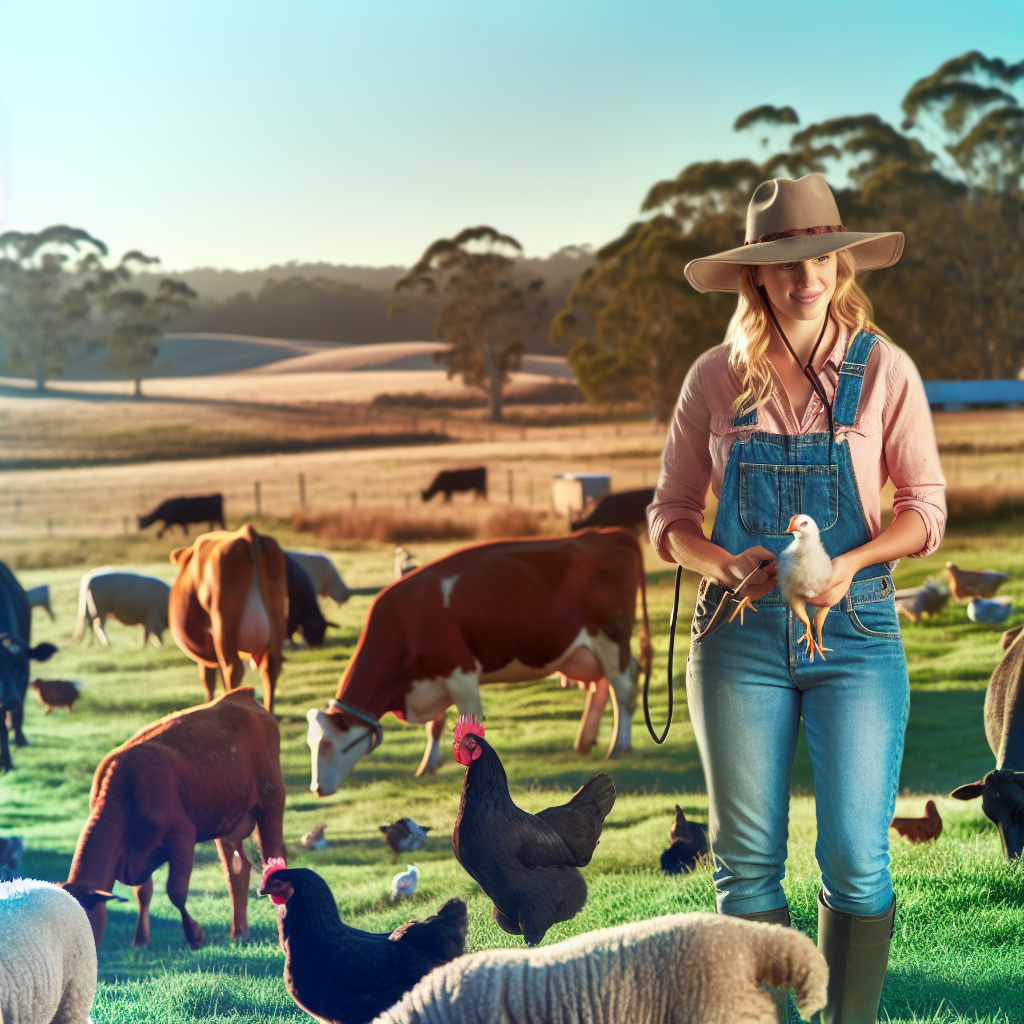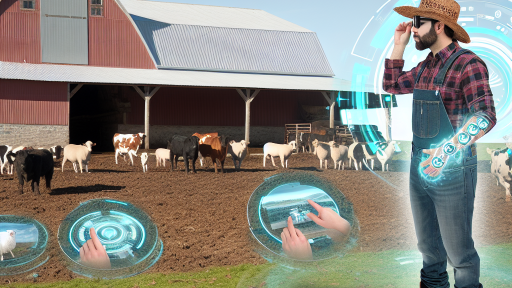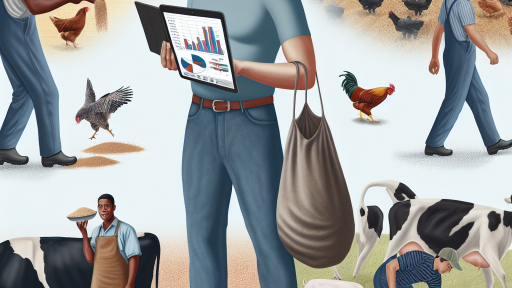Introduction to Livestock Management
Livestock management plays a crucial role in modern agriculture.
Farmers face numerous challenges while managing their livestock.
Understanding these challenges helps in developing effective strategies.
Importance of Livestock Management
Efficient livestock management improves farm productivity.
Healthy animals produce more milk and meat.
Furthermore, proper management ensures the well-being of the livestock.
This approach promotes sustainability in farming practices.
Challenges in Livestock Management
Farmers encounter various obstacles in livestock management.
These include disease outbreaks, feed costs, and labor shortages.
Additionally, climate conditions can affect animal health.
Strategic planning is vital to mitigate these issues.
Health Management of Livestock
Regular health checks are essential for livestock welfare.
Farmers must stay informed about common diseases.
Vaccination programs can significantly reduce disease risks.
Economic Factors
Rising feed costs strain farmers’ budgets.
Transform Your Agribusiness
Unlock your farm's potential with expert advice tailored to your needs. Get actionable steps that drive real results.
Get StartedEfficient feed management can improve profitability.
Farmers must consider alternative feed sources for cost savings.
Labor Management
Labor shortages impact daily operations on farms.
Investing in training can enhance staff efficiency.
Automation tools are becoming increasingly popular in livestock management.
Embracing Technology
Technology offers innovative solutions for age-old problems.
Farmers can utilize software for tracking animal health.
Data analysis tools can optimize feeding practices efficiently.
Moreover, wearable technology provides real-time health monitoring.
Overview of Revolutionary Technologies in Livestock Management
The livestock industry is embracing innovative technologies.
These advancements enhance efficiency and animal welfare.
Farmers can now manage livestock more effectively than ever.
Data Analytics and Management Software
Data analytics tools provide valuable insights into livestock health.
Farmers can analyze trends and make informed decisions quickly.
Management software simplifies record-keeping and compliance.
Remote Monitoring Systems
Remote monitoring technologies allow real-time tracking of animals.
Farmers can assess livestock conditions from anywhere at any time.
This reduces the need for constant physical checks.
Health Monitoring Solutions
Wearable devices track crucial health metrics in livestock.
These devices provide alerts for health issues or anomalies.
Farmers can respond promptly, improving overall herd health.
Environmental Monitoring Tools
Sensors collect data on environmental conditions.
These tools help farmers ensure optimal living conditions for animals.
Maintaining a healthy environment fosters better growth rates.
Showcase Your Farming Business
Publish your professional farming services profile on our blog for a one-time fee of $200 and reach a dedicated audience of farmers and agribusiness owners.
Publish Your ProfileBiotechnology Innovations
Biotechnology plays a significant role in livestock management.
Genetic advancements enable breeders to select desirable traits.
This can lead to increased productivity and disease resistance.
Genetic Testing
Genetic testing provides insights into animal lineage and traits.
Farmers can make better breeding decisions based on solid data.
This increases the chances of producing superior offspring.
Vaccination and Health Solutions
Biotechnology improves vaccine development for livestock diseases.
These advancements lead to more effective and specific treatments.
Farmers can protect their herds more efficiently than ever.
Automated Feeding Systems
Automated feeding technologies streamline the feeding process.
These systems deliver precise amounts of feed to each animal.
This not only reduces waste but also promotes optimal growth.
Customization Features
Many automated systems offer customization based on animal needs.
This ensures that livestock receive balanced nutrition tailored for them.
Monitoring Feed Efficiency
Tracking feed efficiency helps farmers optimize their resources.
It allows for adjustments in feeding regimens as needed.
Drones and Aerial Surveillance
Drones enhance farm management through aerial surveillance.
Farmers can monitor large areas quickly and efficiently.
This reduces labor costs and time for field assessments.
Crop and Land Management
Drones assist in monitoring crop health and soil conditions.
Farmers can make informed decisions regarding land use.
Livestock Location Tracking
GPS tracking devices help monitor livestock movements.
This technology minimizes the risk of losing animals.
Smart Farming: Utilizing IoT Devices for Livestock Monitoring
Introduction to IoT in Agriculture
The Internet of Things (IoT) significantly transforms livestock management.
These devices offer real-time data and insights into farm operations.
Moreover, IoT enhances productivity and efficiency in farming practices.
Benefits of IoT Devices
Implementing IoT devices brings a multitude of advantages.
- Firstly, they provide constant monitoring of livestock health.
- This technology allows for immediate identification of issues.
- Consequently, it leads to proactive measures and timely interventions.
- Furthermore, IoT devices help in managing feeding and breeding schedules.
- This optimization increases overall farm output.
Popular IoT Solutions for Livestock Management
Several IoT solutions are popular among farmers today.
- Wearable health monitors track vital signs of animals.
- Wireless cameras provide live feeds for surveillance and behavior analysis.
- Automated feeding systems ensure precise and timely feeding.
- Environmental sensors monitor climate conditions in barns.
Case Studies of Successful Implementation
Many farmers have successfully integrated IoT into their operations.
For example, the Smith Family Farm uses smart collars for their cattle.
These collars monitor the animals’ activity levels and health metrics.
As a result, they noticed a 20% increase in overall herd health.
Challenges and Considerations
Despite the many benefits, challenges exist in adopting IoT technology.
Initial investment costs can be substantial for small farmers.
Additionally, there are concerns about data security and privacy.
Farmers must also ensure they have stable internet connectivity.
Future Prospects of IoT in Livestock Management
The future of IoT in agriculture looks promising.
We expect advancements in AI will enhance data interpretation.
Moreover, integration with other technologies could further streamline operations.
Ultimately, IoT will lead to smarter, more sustainable farming practices.
Showcase Your Farming Business
Publish your professional farming services profile on our blog for a one-time fee of $200 and reach a dedicated audience of farmers and agribusiness owners.
Publish Your ProfileYou Might Also Like: The Future of Livestock Farming: Embracing Automation and Precision Care
The Role of Drones in Modern Livestock Management
Introduction to Drone Technology
Drones are revolutionizing livestock management techniques.
Farmers now use drones to monitor and manage their animals effectively.
These technologies offer innovative solutions to traditional farming challenges.
Benefits of Using Drones
Drones provide real-time data for effective decision-making.
They improve the efficiency of livestock tracking and management.
Moreover, drone technology helps to save time and reduce labor costs.
- Drones enhance surveillance of large pastures and difficult terrains.
- They facilitate targeted feeding for herds, reducing waste.
- Drones can quickly identify health issues or stress among livestock.
Applications in Livestock Management
Drones are used for aerial monitoring of animal locations.
They capture high-resolution images to assess pasture conditions.
Additionally, drones help collect data for breeding programs.
Monitoring and Surveillance
Drones enable farmers to oversee vast areas without extensive walking.
This surveillance helps detect potential issues promptly.
Health Monitoring
Drones equipped with thermal imaging can detect sick animals.
Early detection leads to better treatment outcomes and herd health.
Challenges and Considerations
While drones offer many advantages, challenges remain.
Farmers must invest in training to operate these devices effectively.
Compliance with regulations concerning drone use is crucial.
- Understanding local laws regarding drone flights is essential.
- Farmers must consider the initial investment costs of drones.
- Ongoing maintenance and software updates require attention.
The Future of Drones in Agriculture
As technology advances, drones will become more accessible.
Integration with AI and machine learning will offer enhanced capabilities.
Future developments may include automated livestock management systems.
Find Out More: What Every Cattle Farmer Should Know About Disease Prevention
Data Analytics in Livestock Health Monitoring
Importance of Data Analytics
Data analytics plays a vital role in livestock health monitoring.
Farmers can leverage data to make informed decisions.
This technology helps in early disease detection.
Moreover, it supports improved animal welfare.
Real-time Monitoring Tools
Real-time monitoring tools enhance livestock health management.
Wearable devices provide continuous health data.
These tools track vital signs and behaviors.
Through this, farmers can promptly address issues.
Data-Driven Decision Making
Data analytics fosters data-driven decision making.
It enables farmers to analyze trends over time.
Consequently, they can identify health patterns.
This approach reduces the risks of disease outbreaks.
Case Studies and Success Stories
Numerous farms have benefited from data analytics.
- The Miller Family Farm saw a 30% reduction in illnesses.
- Smith & Sons Ranch improved overall herd health significantly.
- Johnson Livestock Co. increased productivity by using analytics.
These examples showcase the effectiveness of the technology.
Integrating Technology with Traditional Methods
Integrating technology with traditional farming methods is crucial.
This combination enhances livestock management strategies.
Farmers can use analytics alongside their existing knowledge.
Ultimately, this leads to better health outcomes.
Discover More: Top Livestock Management Tips from Expert Farmers
Showcase Your Farming Business
Publish your professional farming services profile on our blog for a one-time fee of $200 and reach a dedicated audience of farmers and agribusiness owners.
Publish Your Profile
Precision Feeding: Tools and Technologies for Optimal Nutrition
The Importance of Precision Feeding
Precision feeding optimizes livestock nutrition and health.
This approach enhances feed efficiency and supports growth.
Farmers can reduce waste and minimize costs.
Furthermore, it contributes to improved animal welfare.
Technology Driving Precision Feeding
Advanced technologies shape modern precision feeding practices.
Smart feed systems adjust rations based on real-time data.
For instance, automated feeders track individual animal intake.
This ensures each animal receives the right nutrients.
Software Solutions
Feed management software simplifies dietary adjustments.
Programs like FeedWatch enable farmers to track nutrition over time.
These solutions provide insights into feed conversion ratios.
Additionally, they help in managing feed inventory efficiently.
Wearable Technology
Wearable devices offer vital health metrics about livestock.
Collars and ear tags monitor activity levels and behavior.
This data helps optimize feeding schedules and practices.
As a result, farmers can identify and address health issues early.
Benefits of Precision Feeding
Precision feeding improves overall productivity on farms.
It leads to healthier animals and better weight gain.
Moreover, it minimizes environmental impact through reduced waste.
This approach supports sustainable farming practices.
Cost Efficiency
Implementing precision feeding cuts down on feed costs.
Farmers can eliminate excess feed and optimize purchasing.
Additionally, it enhances profitability by improving animal output.
Improved Animal Health
Proper nutrition directly influences livestock health.
Precision feeding reduces the risk of nutritional deficiencies.
Healthy animals lead to better reproductive success and longevity.
Implementing Precision Feeding on Your Farm
To start, evaluate your current feeding practices.
Identify areas for improvement and potential technology adoption.
Consider investing in feed management software.
Additionally, explore wearable technology options to gather data.
Training staff on new technologies is crucial.
Regular monitoring and adjustments will yield the best results.
Finally, engage with professionals for ongoing support and advice.
Explore Further: Essential Equipment for Modern Pig Farms
Automated Health Management Systems and Their Impact
Overview of Automated Health Management Systems
Automated health management systems transform livestock care.
These tools utilize technology to monitor animal health consistently.
Farmers can access real-time data and analytics easily.
Consequently, they make informed decisions quickly.
Benefits of Implementing Automation
Automation reduces labor costs significantly.
Farmers can focus on other critical tasks.
Showcase Your Farming Business
Publish your professional farming services profile on our blog for a one-time fee of $200 and reach a dedicated audience of farmers and agribusiness owners.
Publish Your ProfileAdditionally, farmers notice improved animal welfare overall.
Health issues are detected earlier than traditional methods allow.
Technological Features to Look For
Look for systems that offer remote monitoring capabilities.
Data analytics should provide insights into health trends.
Integration with existing farm management software is essential.
Consider platforms that support user-friendly interfaces.
Case Studies of Successful Implementation
Sunny Meadows Farm successfully integrated an automated system.
They observed a 30% reduction in veterinary costs.
Moreover, animal health improved significantly over two years.
Green Pastures Ranch also reported similar successes.
Challenges to Consider
Initial costs of implementing these systems can be high.
Training staff to use new technologies may require time.
Additionally, data security is a concern for many farmers.
Farmers must evaluate solutions carefully before committing.
Future of Livestock Management Technology
The future holds promising advancements in livestock management.
Artificial intelligence will enhance data analysis capabilities.
Wearable technology for animals will increase in prevalence.
Farmers will continue to embrace automation for greater efficiency.
The Future of Artificial Intelligence in Livestock Breeding Programs
Transforming Breeding Efficiency
Artificial intelligence revolutionizes livestock breeding programs.
It enhances the selection process by analyzing genetic data.
Farmers now achieve faster and more accurate breeding decisions.
As a result, productivity increases significantly across farms.
Data-Driven Decision Making
Data analytics improves decision-making in livestock management.
Farmers can analyze trends in breeding outcomes effectively.
AI algorithms identify the best genetic pairings for livestock.
This ultimately leads to stronger and healthier animals.
Predictive Analytics in Health Management
AI helps predict health issues before they arise.
Farmers use real-time data analytics to monitor livestock health.
This proactive approach reduces veterinary costs substantially.
Consequently, overall herd productivity experiences a boost.
Enhancing Traits through Genetic Engineering
AI assists in improving desirable traits in livestock.
Farmers can enhance growth rates and feed efficiency.
Moreover, disease resistance traits are integrated more effectively.
The result is a more resilient livestock population.
Streamlining Record Keeping
Artificial intelligence simplifies record-keeping processes.
Farmers benefit from automated tracking and data entry.
This reduces human error and saves considerable time.
As a result, farmers can focus on more critical tasks.
Cost Reduction and Profit Increase
Using AI in livestock breeding lowers operational costs.
More efficient breeding programs lead to higher profit margins.
Showcase Your Farming Business
Publish your professional farming services profile on our blog for a one-time fee of $200 and reach a dedicated audience of farmers and agribusiness owners.
Publish Your ProfileAdditionally, farmers can adapt quickly to market demands.
This flexibility further boosts profitability in the long run.
Future Prospects and Innovations
The integration of AI will continue to evolve in farming.
Emerging technologies promise even greater advancements.
Farmers will likely adopt more sophisticated AI tools.
This will lead to an industry-wide transformation in livestock management.
Additional Resources
Precision Agriculture for Crop and Livestock Farming—Brief Review …




